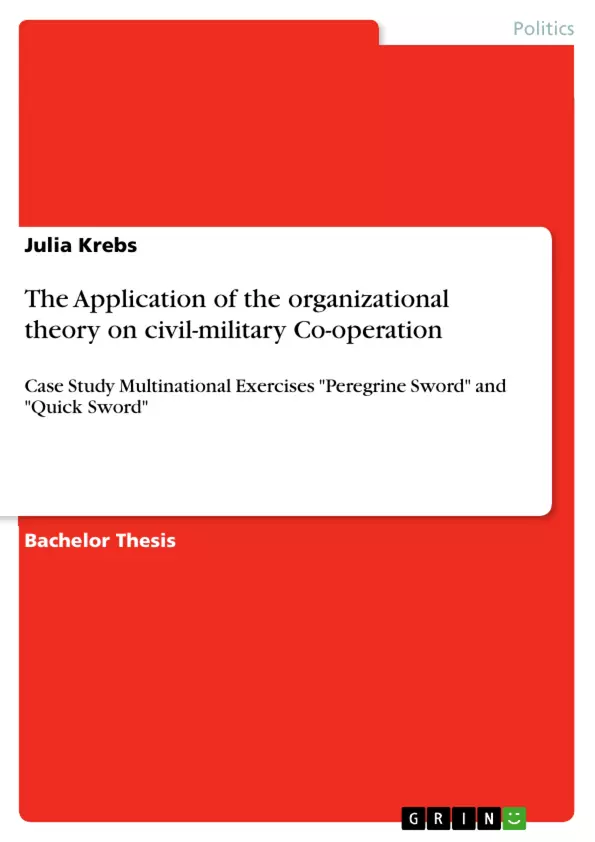Civil-military cooperation has been becoming increasingly important in peace-keeping and natural disasters. An effective cooperation between civil and military actors facilitates the integrated mission in the specific host country.For this reason both civil and military actors developed guidelines on how civil-military cooperation should ideally work.
There are, however, conflicts that arise between civil and military actors. Due to different objectives of the organizations, there are disputes on how things should be done. There has already been research on how to analyze the differences and how to solve them but a solution has not been found yet.
In this bachelor thesis the Organizational Theory Modell is presented to explain theese conflicts. The Organizational Theory Modell is used by Graham Allison and Philip Zelikow to explain events that happened during the Cuban Missile Crisis. This approach to explain international conflicts is so far unique.
During the civil-military exercises of the first German-Netherlands Corps, one of the training objectives was to train civil-military cooperation. Also during these exercises, conflicts occurred between the civil and the military side. To make the conflicts better understandable the method of critical incidents of Alexander Thomas is used. He uses this method to describe critical incidents between different cultures. The method of critical incidents is altered in this paper to be applied on civil and military actors. After a description, the situations are analyzed with the Organizational Theory Model.
Inhaltsverzeichnis (Table of Contents)
- Introduction
- Civil-Military Co-Operation
- Civil Military Cooperation - NATO concept.
- Civil-Military Coordination – UN-Concept.
- Humanitarian Principles
- Arising Conflicts
- The Essence of Decision: Organizational Theory applied to the Cuban Missile Crisis
- The Essence of Decision – Background
- Organizational Theory
- Bureaucracy Theory.
- Scientific Management.
- Contemporary Bureaucracy Theory: James March and Herbert Simon.
- The Human Relations Movement.
- Contingency Theory - Joan Woodward
- Organizational Culture
- Case Study Peregrine Sword
- Purpose of the Exercises
- Procedure of the Exercises
- Background of the Exercises: "Tytan" Conflict
- Application of the Organizational Theory
- Critical Incidents
- Conclusion
Zielsetzung und Themenschwerpunkte (Objectives and Key Themes)
This bachelor thesis aims to explain conflicts arising between civil and military actors within the context of civil-military cooperation, particularly in peacekeeping and natural disasters. It utilizes the Organizational Theory model, as presented by Graham Allison and Philip Zelikow in their work "The Essence of Decision," to analyze these conflicts. The thesis examines the application of this theory in a case study focusing on the Peregrine Sword exercises, a series of joint German-Netherlands military exercises, where civil-military cooperation was a key training objective. Key themes explored in the thesis include: * **Civil-Military Cooperation:** Examining the concepts and principles underlying successful civil-military cooperation in various international contexts. * **Organizational Theory:** Applying the theoretical framework of Organizational Theory, particularly in the context of the Cuban Missile Crisis, to understand conflicts arising from differing organizational structures and objectives. * **Conflict Analysis:** Employing the critical incident method to identify and analyze specific conflicts that occurred during the Peregrine Sword exercises. * **Case Study Analysis:** Utilizing the Peregrine Sword exercises as a case study to assess the practical application of the Organizational Theory model in understanding and addressing real-world civil-military conflicts.Zusammenfassung der Kapitel (Chapter Summaries)
* **Introduction:** This chapter introduces the overarching theme of civil-military cooperation in the context of peacekeeping and disaster relief. It establishes the importance of effective coordination between civil and military actors to achieve integrated mission success. * **Civil-Military Co-Operation:** This chapter delves into the concepts and principles of civil-military cooperation as defined by both NATO and the UN. It also examines the principles of humanitarian action within the framework of civil-military cooperation. * **Arising Conflicts:** This chapter explores the various challenges and conflicts that can arise between civil and military actors due to differing organizational objectives and operational approaches. * **The Essence of Decision: Organizational Theory applied to the Cuban Missile Crisis:** This chapter introduces the Organizational Theory model, which serves as the theoretical foundation for the thesis. It examines the application of this model in understanding the Cuban Missile Crisis, highlighting its value in explaining international conflicts. * **Case Study Peregrine Sword:** This chapter presents a case study focusing on the Peregrine Sword exercises, providing context for the analysis of civil-military conflicts within a specific training scenario. * **Application of the Organizational Theory:** This chapter applies the Organizational Theory model to analyze specific critical incidents that occurred during the Peregrine Sword exercises. It utilizes the method of critical incidents, adapted for this context, to identify and examine specific instances of conflict between civil and military actors.Schlüsselwörter (Keywords)
The key focus of this thesis lies in the intersection of civil-military cooperation, organizational theory, conflict analysis, and international relations. The work explores concepts such as: civil-military coordination, NATO and UN principles, organizational structures, bureaucratic theory, scientific management, human relations theory, contingency theory, critical incidents, case studies, and the Peregrine Sword exercises. The research aims to contribute to a deeper understanding of the complexities and challenges inherent in civil-military cooperation, particularly through the lens of organizational theory.- Citation du texte
- Julia Krebs (Auteur), 2013, The Application of the organizational theory on civil-military Co-operation, Munich, GRIN Verlag, https://www.grin.com/document/231396



